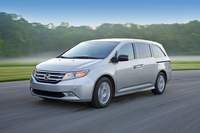2011 Honda Odyssey Review
SEE ALSO: Honda Buyers Guide
SEE ALSO: E-Carmony: Is the 2011 Honda Odyssey Your Perfect Match?
Honda Odyssey for 2011
By Thom Cannell
Senior Editor
Detroit Bureau
The Auto Channel
Why does Honda have the guts to develop an all-new minivan when GM and Ford have abandoned the market? Though sales have dropped, annual sales of half a million per year makes the minivan market larger than many and, one supposes, profitable. And why does Honda think it can outsmart perennial leader Chrysler? That is the story.
Today’s minivan intenders and prospectors are the first kids who to grow up inside those early boxes on wheels. As infants, toddlers and adolescents they were car seated, booster seated, soccer-baseball-football-hockey trans-sported in minivans and very likely went to their proms aboard a minivan (not to mention the extreme likelihood their first kiss occurred behind a sliding door). These new and soon-to-be parents are, at least potentially, not put off by the image of soccer mom and car pool carrier, though research says they lust for BMWs, S/CUVs and Mustangs.
For them, Honda has built a minivan that combines the best minivan attributes along with sport sedan styling while offering sufficient technology to inspire the next FaceBook-like leap of imagination. In short, the 2011 Odyssey easily overcomes its potentially dowdy image.
The new Odyssey was introduced at the Chicago Auto Show as a concept and is little changed. Its signature lightning bolt zigzag side view revitalizes its necessarily boxlike shape and creates an appearance that is sleek and swift, if not racy. Production versions seen either head on or from the rear to be very stylish, better proportioned than most non-sedans of any ilk, and not at all like a brick or barn side. A recent brief test drive disclosed other facts about Odyssey.
Honda asserts that Odyssey has great technology, enviable power and fuel economy, and driving characteristics more sedan than van. These are reasonable claims and we have only minor quibbles about them. Certainly Honda’s power train expertise and the V-6 engine that drives the vehicle is almost magically smooth and complex, shifting seamlessly from using all six cylinders to accelerate briskly and then to four, or even three cylinders to cruise economically. This is not new, but the 3.5-liter 248 hp i-VETEC retains all of its magic and mojo. Mated to a five or six-speed automatic transmission (who would want anything else?), it powers the two and a quarter-ton vehicle to highway speed with grace and finesse. Any transition from powerful passing to more economical cruising goes almost totally unnoticed and five-speed versions deliver 18 mpg City and 27 Highway for a combined 21 mpg average (+1 mpg for 6-speed transmission-equipped models).
Honda also says the vehicle has sporty driving character with a 56/44% weight distribution and improved brakes. Clearly it aspires to sportiness, riding solidly over bad and worse roads while delivering responsive directionality in rain. However the steering is somewhat on the rubber-bandish side of direct when moving off center for our tastes and, while boasting a supportive and massively rigid chassis that never puts a tire wrong, cannot be described as actually sporty. Despite minor negatives (we thought the brakes exhibited more than a hint of sogginess, though solid), Odyssey is better connected to the road than any minivan we’ve driven.
Where Odyssey truly displays differentiation is in its adaptability and interior style. For instance, the front door bins might accommodate most of a paperback library or the most capacious clutch bag while holding any manner of beverage container. The way its multitude of interior surfaces creates harmony would be more familiar to shoppers of Bergdorf Goodman’s or Lord & Taylor than Gap, American Eagle, or Forever 21.
Instruments are clear and the center stack that holds controls for climate and entertainment could be delivered as your den’s media center, complete with a large video screen. That screen—navigation, not television—is easy to understand—once you understand it. We had trouble figuring out how to change mapping scale; it is blindingly obvious once understood. The nav screen is used for a multitude of operations: climate control, rear view camera, incoming call numbers, XM and CD information, and traffic map display.
Depending on model (an LX starts at $27,800 plus destination to the ultra-premium Touring Elite at $43,250) more features are piled on, from the navigation system to humidity-controlled climate control, a variety of audio systems, and a “must have” 16.2” rear video display that can show two channels (video or game systems) simultaneous. How’s that for keeping the back seat free of disputes?
Regardless of price, the functions of a minivan are retained and improved. The third row seat is, as a matter of fact, comfortable for adults of more than modest size and access to that former purgatory is truly easy enough for a child’s muscles. The 60/40 split third row Magic Seat now folds into the floor with a single tug of the pull-rope and the front center console is removable. If you wish, (removable) second row seating can slide outward, and back in to increase elbow room or ease access to the third row. Heck, there’s even a six-pack sized cool box and a bin just for your mobile devices (think handsfree.) This is a very well developed minivan, one conceived, designed, engineered and built in the US.



